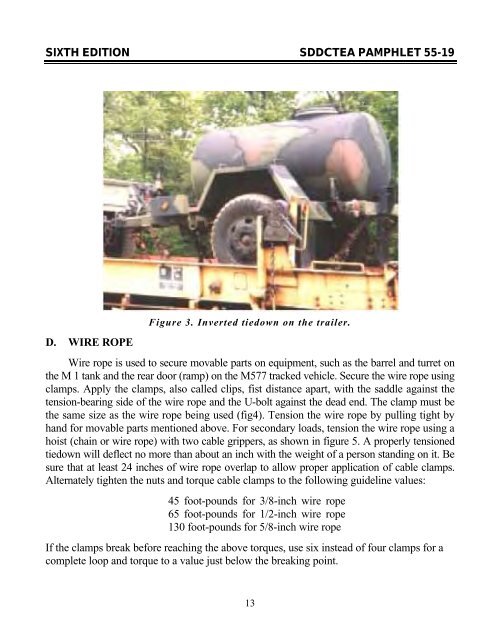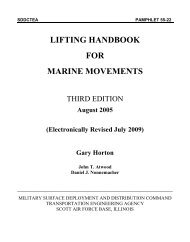Tiedown Handbook For Rail Movements - SDDCTEA - U.S. Army
Tiedown Handbook For Rail Movements - SDDCTEA - U.S. Army
Tiedown Handbook For Rail Movements - SDDCTEA - U.S. Army
You also want an ePaper? Increase the reach of your titles
YUMPU automatically turns print PDFs into web optimized ePapers that Google loves.
SIXTH EDITION <strong>SDDCTEA</strong> PAMPHLET 55-19<br />
D. WIRE ROPE<br />
Figure 3. Inverted tiedown on the trailer.<br />
Wire rope is used to secure movable parts on equipment, such as the barrel and turret on<br />
the M 1 tank and the rear door (ramp) on the M577 tracked vehicle. Secure the wire rope using<br />
clamps. Apply the clamps, also called clips, fist distance apart, with the saddle against the<br />
tension-bearing side of the wire rope and the U-bolt against the dead end. The clamp must be<br />
the same size as the wire rope being used (fig4). Tension the wire rope by pulling tight by<br />
hand for movable parts mentioned above. <strong>For</strong> secondary loads, tension the wire rope using a<br />
hoist (chain or wire rope) with two cable grippers, as shown in figure 5. A properly tensioned<br />
tiedown will deflect no more than about an inch with the weight of a person standing on it. Be<br />
sure that at least 24 inches of wire rope overlap to allow proper application of cable clamps.<br />
Alternately tighten the nuts and torque cable clamps to the following guideline values:<br />
45 foot-pounds for 3/8-inch wire rope<br />
65 foot-pounds for 1/2-inch wire rope<br />
130 foot-pounds for 5/8-inch wire rope<br />
If the clamps break before reaching the above torques, use six instead of four clamps for a<br />
complete loop and torque to a value just below the breaking point.<br />
13




